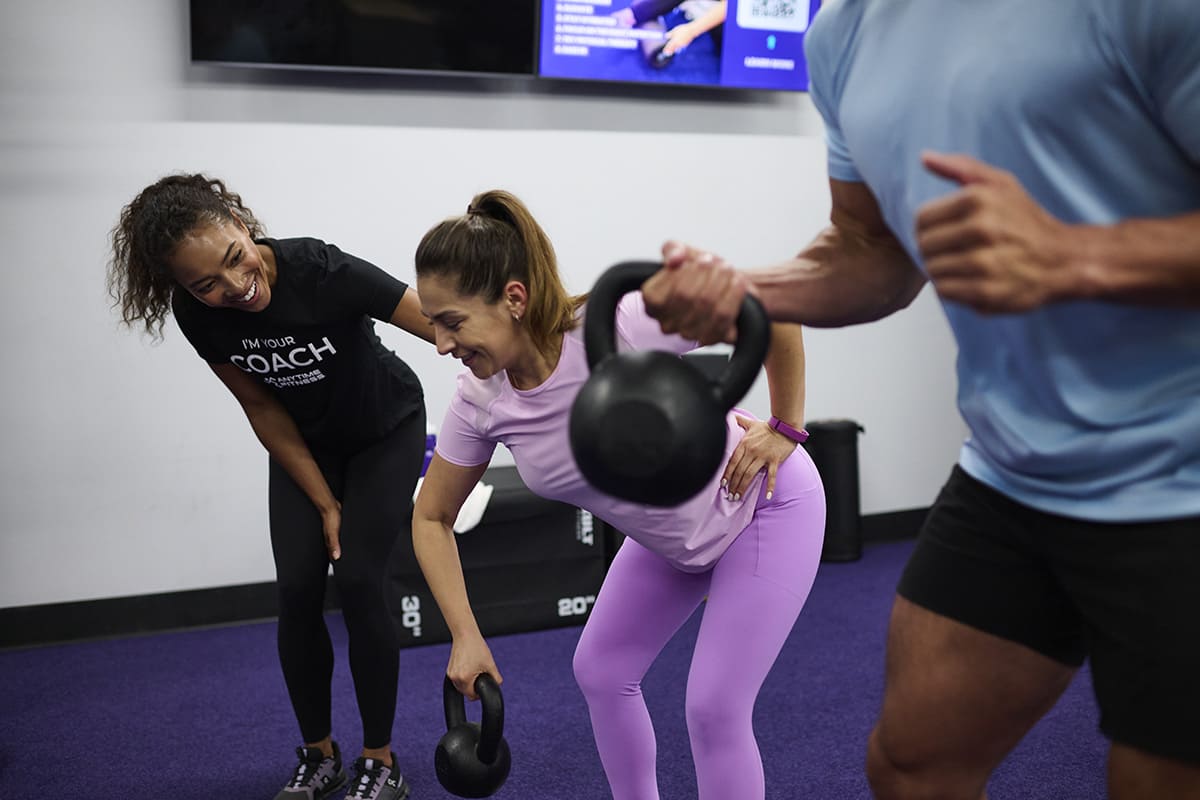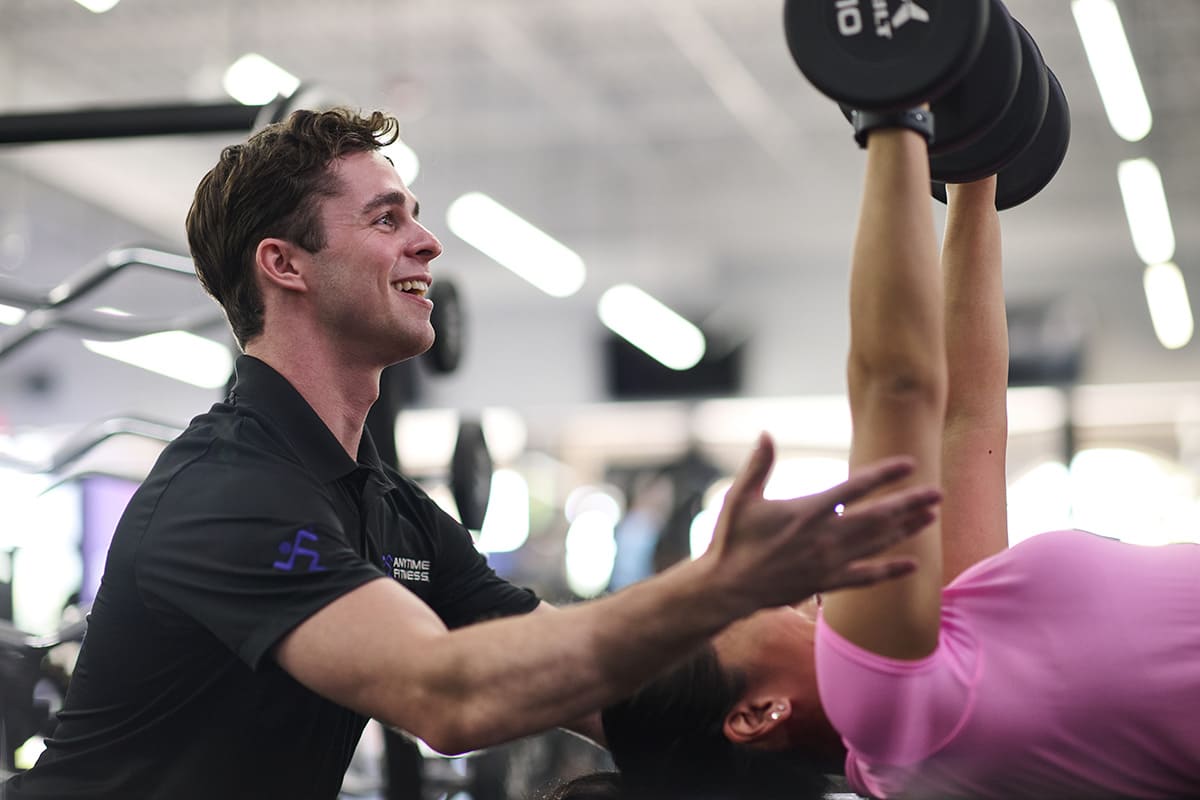Everyone’s fitness journey is one of a kind and ever-evolving. Along that journey, you’re likely to encounter strength training. Maybe you’ve seen the equipment in the gym and it piqued your interest, or maybe you’ve heard weightlifting terms from others who swear by it. Whether you’re a new lifter or are simply ready to take the first step forward, this guide is designed to help you actively work toward your goals and enjoy all the benefits strength training has to offer (support for bone health and muscle mass; improved balance, mobility and longevity; and reduced risk of injury — just to name a few).
We’ll cover the key weightlifting terms you need to know as well as how to use them to progress forward in the areas you’re working on, or will be working on next. Think: detailed exercises and information to help you determine what you’re most interested in, for topics including:
- Anatomy
- Muscles and strength
- Movement and form
- Energy, metabolism, and body composition
- Strength training and workout programming techniques
- Systems of resistance training
- Key equipment and how it’s used
- Bonus: Weightlifting abbreviations often used in the gym
It starts with the body: Key weightlifting terms and definitions to support safety
To make strength training a sustainable part of your life (and to make the progress you want to see), it’s essential to understand your body. From intentional breathing to proper recovery, caring for your body is the first and most important step before handling any equipment.
Learning about the items below will set you up for the weightlifting terms that follow, helping you understand the body’s relationship to each exercise movement. By building an awareness of safety and taking measures to protect yourself with proper form and recovery, you’ll be empowered to keep making strength training progress over the long run.

Anatomy terms to know
- Diaphragmatic breathing: Deep breathing that causes the belly to expand.
- Cardiorespiratory fitness: The ability of the heart, lungs, and supporting systems to oxygenate the body during activity.
- Core: Includes the lower back, pelvis, abdomen, and hip joint.
- Core strength: The ability to control the motion of the spine.
- Core stability: The ability to maintain a given position, adequately stabilizing the spine while the arms and legs are in motion.
- Bracing: Contracting the core muscles such as the rectus abdominis and obliques at the same time.
Muscle and strength terms to know for weightlifting
- Strength: The ability of the nervous and muscular systems to work together to produce enough force to overcome a load.
- Strength training: Lifting heavier loads week by week (or over time) to increase maximal strength.
- Muscular hypertrophy: The growth of a skeletal muscle to be larger in size.
- Hypertrophy training: Causes increases in muscle tissue size. This is ideal for lifters who are looking to increase muscle growth.
- Stability: The body’s ability to keep proper posture during movement.
- Stabilization training: An important phase of training for beginners where movement patterns and stability are the focus.
- Muscular endurance: The ability to produce force for long periods of time.
- Type I muscle fibers: Muscle fibers that are small, generate lower amounts of force, and are slower to fatigue. These are also called slow-twitch muscles.
- Type II muscle fibers: Muscle fibers that are larger, generate more force, and are quick to fatigue (unlike Type I muscle fibers). These are also called fast-twitch muscles.
Movement and form terms to know
- Movement assessment: Examines the movement patterns and posture during movement. This is often done by a fitness professional such as a Coach at the start of a program or to check progress along the way.
- Static posture: The alignment and positioning of the musculoskeletal system while standing.
- Dynamic posture: The alignment of the body while moving, such as during a squat, press, or pull.
- Deconditioned: Having low physical fitness. Signs include muscle imbalances, loss of flexibility, and a lack of stability.
- Muscle imbalance: When one muscle around a joint is tight, and the other is lengthened. This causes improper movement and function.
- Flexibility: The normal extensibility of muscles, tendons, and ligaments that allows for a full range of motion in the joint.
- Mobility: The ability to move freely due to flexibility and proper range of motion around a joint.
- Overactive: A muscle that is chronically contracting (tight).
- Underactive: A muscle that has lower activation from the nervous system and therefore is weakened.
- Range of motion (ROM): Describes the degree to which joints can move.
- Neuromuscular efficiency: The ability of the nervous system to activate the body’s muscles to produce optimal movement — aka the “mind-muscle connection.”
Energy, metabolism, and body composition terms to know
- Total daily energy expenditure (TDEE): The estimated number of calories you need to maintain your current weight based on your activity level.
- Non-exercise activity thermogenesis (NEAT): The amount of energy used during unstructured activity in the day such as walking or taking the stairs.
- Macronutrients: Fat, carbohydrates, and proteins. These are the three major sources of the essential nutrients your body needs for energy.
- Caloric deficit: Taking in fewer calories through food and drink than are expended (TDEE) over the course of a day.
- Basal metabolic rate (BMR): The amount of energy required to keep the body at homeostasis while at rest.
- Body mass index (BMI): The measurement of a person’s weight relative to height, which is often used in the medical profession to estimate the risk of obesity.
- Bioelectrical impedance analysis (BIA): A body composition test technique that estimates body fat percentage by measuring how much the body resists the flow of electrical currents. This is sometimes referred to as a body scan.
- Body composition: The relative proportion of tissues in the body such as fat, muscle, water, and bone.
- Resting heart rate (RHR): The number of heartbeats per minute while at complete rest.
- Heart rate (HR): The measurement of the number of times a heart beats within a specified time (usually one minute).
- Recovery heart rate: The number of heartbeats measured after exercise ends, which provides information about fitness level (example: people who are more conditioned recover more rapidly).
- Target heart rate: A predetermined goal heart rate during exercise.
Let’s break it down: Strength and resistance training terms to support success
Now that we have terminology for the body covered, let’s talk about strength training terms. If you’re a lifter, you may have come across terms like “snatch,” “clean,” and “jerk” — all of which are used to describe different parts of the barbell lift in Olympic weightlifting. But if you’re starting out your lifting journey, this could be more information than you need. With so many terms out there, things can quickly become confusing.
To help cut through the noise and create a solid foundation, we’re sharing the definitions that you can actively apply and use. Whether that’s by practicing a specific technique, adding new layers of complexity to your existing workout, or becoming more aware of recovery tools, the terms below offer a guide to the core training language that will pave the way for your long-term success.

Strength training program terms and techniques
- Periodization: Planning out how training variables will change week by week or over time to improve performance.
- Linear periodization: Gradually increases training intensity while training volume decreases.
- Undulating periodization: Changing variables (volume, intensity, and exercise selection) within a weekly program.
- High-intensity interval training (HIIT): Training with repeated intervals of high-intensity work with short rest periods in between.
- Steady-state cardio: Exercise with a relatively constant intensity so there are no dips or spikes in heart rate.
- Rate of perceived exertion (RPE): A subjective rating of exercise difficulty, on a scale of 1-10.
- Progressive overload: Gradually and intentionally increasing exercise intensity or volume.
- Resistance training: Using external resistance such as weights, resistance bands, or even the weight of the body to increase muscular strength and endurance.
- Fundamental movement patterns: Movements in exercise that mimic daily activities, such as pushing, pulling, squatting, hinging, and rotating.
- Overtraining: Occurs when workouts are too frequent (think: every day of the week) or when volume or intensity are not met with proper rest and recovery. This leads to decreased performance.
- Static stretching: Holding a stretch at the point of tension (example: holding a forward fold for 30 seconds).
- Dynamic stretching: Uses the body’s momentum to take a joint through the available range of motion (example: leg swings).
- Self-myofascial techniques: Used for breaking up adhesions of the fascia and the surrounding muscle tissues (example: foam rolling).
- Delayed-onset muscle soreness (DOMS): Discomfort often felt 24-72 hours post-workout, especially for people who are deconditioned, or when incorporating new or more intense activities.
- Progression: Advancing the intensity and/or volume to provide a greater challenge.
- Plyometrics: Explosive movements such as box jumps that involve powerful and explosive muscle actions.
Systems of resistance training:
- Warm-up set: One to two sets at a low intensity to mentally and physically prepare for a workout.
- Pyramid: Increasing (or decreasing) weight with each set.
- Complex training: Performing a multi-joint or compound exercise immediately followed by an explosive movement (example: a barbell squat followed by a box jump).
- Drop set: Performing a set to failure, then removing a small amount of weight before continuing with additional sets.
- Superset: Two exercises (usually of the same muscle group) performed back-to-back with little rest, to increase muscular endurance.
- Circuit training: Performing a series of exercises, one after the other, with minimal rest.
- Training split: A training routine that focuses on different body parts on different days of the week.
Strength training equipment guide
Learn about essential equipment, what it looks like, and how to use it.
62. Free weights: These include barbells and dumbbells. Dumbbells engage all three planes of motion (side to side, front to back, and rotation) while barbells can be loaded with plates to the desired weight.
63. Cable machines: These have various handles and grips that can be used attached to a cable pulley system. They offer a wide variety of movements without the need for a spotter.
64. Resistance bands: These are tubing with handles or mini-bands. They are inexpensive, easy to transport, and used on the go to improve joint stability and muscular endurance. They’re often used in injury rehab or physical therapy.
65. Medicine balls: These are solid balls that come in a variety of weight increments. These can be thrown, caught, and used for resistance for a wide variety of exercises.
66. Kettlebell: This is a flat-bottomed ball with a handle. It improves strength and coordination as well as stability due to the center of gravity being off-center.
67. Bodyweight training: This uses one’s body weight as resistance. It does not require additional equipment and is often used to train core, balance, and plyometrics.
68. Battle ropes: These are also called fitness ropes or training ropes. They offer full-body conditioning and cardiovascular benefits in a short amount of time.
69. Stability ball: This is also called a Swiss ball. It is often used in core and stability training, injury rehab, or physical therapy, and can be used to reinforce proper posture during exercise.
Bonus: Weightlifting abbreviations frequently used in the gym
70. PR/PB: Stands for “personal record” or “personal best” — this refers to the most weight lifted for a person to date on a specific exercise such as bench press, squat, or deadlift.
71. Pump: The feeling and appearance of enlarged muscles following an intense workout, which is common for lifters.
72. Gains: Increases in muscle mass as measured by circumference or body scan.
73. Cutting: The deliberate loss of body fat achieved by maintaining a caloric deficit.
74. Bulking: Deliberately taking in more calories than the body needs per day (TDEE) with the goal of building additional muscle mass.
75. AMRAP: Stands for “as many reps as possible” — a workout format where you perform as many reps as possible, with proper form, during a given time interval. The goal is to increase muscular endurance.
76. EMOM: Stands for “every minute on the minute” — a workout format with a predetermined number of reps per exercise that begin at the top of the minute. Any time remaining after completing the reps is to be used as rest before the next minute begins.
Next up: Put these weightlifting terms to use in the gym!
If it seems like there’s a lot of weightlifting terminology out there, you’re right! Here’s the good news: You don’t need to learn it all at once. These core weightlifting terms are your guide to safety and success, and focusing on a few terms at a time can help you work toward your personal fitness goals with education and intention.
When you practice strength training consistently, you’ll not only become stronger, more toned, and build increased endurance — you’ll also notice these lifting terms become second nature as you start to apply them. Come back to this exercise glossary any time you need a quick refresh or inspiration to switch up your workout routine and try something new.
Ready to put these terms into action? Start building strength at an Anytime Fitness gym near you — or work with an expert Coach to maximize gains with one-on-one training.





%20(1)%20(1).avif)
